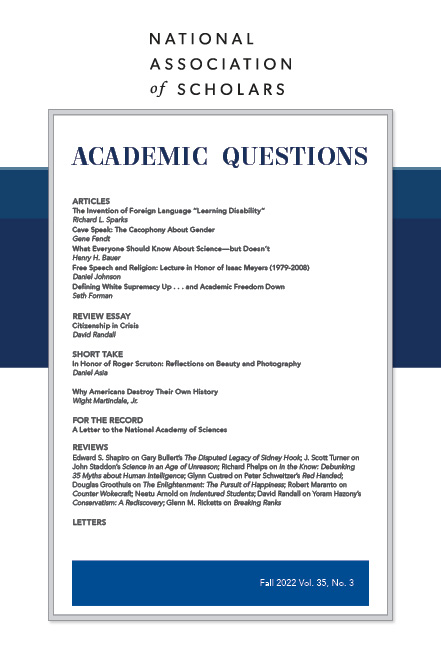Dan Asia is an American composer whose work ranges from solo pieces to large scale multimovement works for orchestra and includes six symphonies. Since 1988, Asia has been Professor of Composition and head of the composition department at the University of Arizona in Tucson; [email protected]. He wrote “Where Does the University Go from Here?” for our Summer 2021 issue.
Sir Roger Scruton wrote Beauty: A Very Short Introduction in 2011. It is indeed a small book, only 208 pages, but one that must be read slowly, to savor every well-constructed thought and sentence. He tells us that Beauty comes in many forms and shapes. We find it in nature, in persons, in artistic objects, in actions, and even in scientific formulas. It can be found in shapes, colors, sounds, and thoughts. It can be found in novels, stories, poems, plays, and music. It can have monetary value, or not, and still be beautiful. It can also be ugly, but in its truthfulness, beautiful. Scruton surveys the beauty of the arts with a very wide lens, scrutinizing architecture, painting, and—with an insight second to none (particularly for philosophers, who frequently tend to be rather tone deaf)—music. But photography is almost nowhere to be found.
However, in The Aesthetic Understanding: Essays in the Philosophy of Art and Culture (1983), Scruton explored the nature of photography in his essay “Photography and Representation.” His view of photography then was not particularly positive. And since it is hardly mentioned in Beauty (2011), we can assume his views did not change much in the intervening years. The essay deals with the question of representation, as in representational art, both in photography and painting, and “whether that feature has in each case a comparable aesthetic value.” He also makes the wonderful analogy to music with the following parenthetical comment: “There is an important feature—sound—in common to music and to fountains, but only the first of these is properly described as an art of sound.” (original emphasis) This comment prepares us for a latter point: that great cinema, being ultimately tied to drama, can be as good as painting, and that photography, being more like the fountain, is not.
To follow on the musical analogy for a moment, it should be mentioned that many composers, from John Cage to Toru Takemitsu, use the sound of water (and of nature) in musical compositions, albeit of an electro-acoustic kind. They recorded sounds of water, and either presented those sounds unembellished or in some manipulated form. Thus, these works may correspond to Varese’s expansive notion of what was then the new music as “organized sound,” or to Duchamp’s found object (readymades), or the manipulations of those objects. One might also mention the collages of Rauschenberg, among others, that in a similar fashion disrupt our notion of the representational, or even of beauty.
Scruton says that “to understand a painting involves understanding thoughts.” A photograph does not, he thinks. Yet he does say “the [painterly] artist presents us with a way of seeing (and not just any way of thinking of) his subject.” Is this not just what the photographer does? “With an ideal photograph it is neither necessary nor even possible that the photographer’s intention should enter as a serious factor in determining how the picture is seen.” In my opinion, this is wrong in the case of photography and any art, as opposed to a craft or a work of entertainment, and is a misunderstanding of the artistic and photographic process. The photographer, who is not a documentarian but an artist, is providing everything that he is as a person and artist in the creation of the picture. Not just his artistic sensibility in crafting the photograph, in presenting us with his particular view of nature, a person, or just some random combination of light after all—that which is fundamental to both painting and photography (even if only black and white)—but then in the entire aftermath of the photograph’s production. He is creating the representation with thought and skill, and with intentionality. And intentionality can only be had by means of will and thought. Why take a picture from a certain angle; with a particular lighting; at a particular time? How can the photographer not provide us with his thoughts on his photograph, or how it is seen?
Scruton mentions photographs only sparingly in Beauty: “there is a great difference between the artistic treatment of a subject-matter and the mere cultivation of effect. The photographic image has to some extent deadened us to the contrast here.” With the iPhone, Android, and social sites, pictures are more ubiquitous than ever before. The “artistic treatment” nonetheless remains a specific domain of the artist. Unless the artist takes a Cagean or Duchampian approach, and relinquishes all control over the artistic outcome, the artist must make crucial decisions throughout the artistic process. This is true no less of the photographer than the painter, composer, or choreographer. That this is accepted within the artistic and museum community is a given, and has been for over a century or so. One need only refer to the collections of the Metropolitan Museum of Art and the Museum of Modern Art and photographs by Eugene Atget, Alfred Stieglitz, Man Ray, Irving Penn, Dorothea Lange, Harry Callahan, and Edgar Weston, or look at three of the greatest photographs, Stieglitz’s The City of Ambitions (1911), Weston’s Nautilus (1927), and Penn’s Rag Face (1975), to make the case. This is to say, on the question of photography as an art form, Scruton is in the minority.
I am sorry that Sir Roger is no longer here to engage in the conversation, but we can do so in his honor, using some of the aesthetic ideas he has given us.
Image: Fronteiras do Pensamento, Wikimedia Commons, Public Domain












